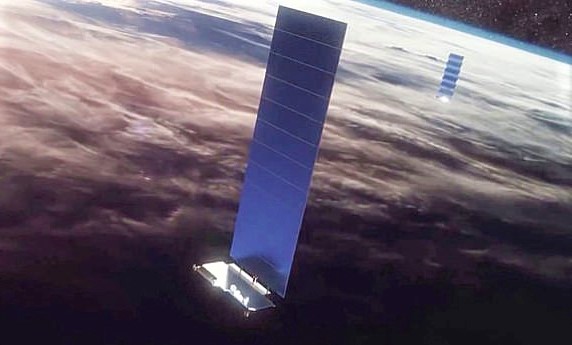OneWeb and SpaceX, the powerhouses in the internet satellite industry, had dangerously close encounter last weekend that was out of this world.
Two satellites from each firm came within 190 feet of each other in orbit April 4, which sparked several ‘red alerts’ from the US Space Force’s 18th Space Control Squadron.
The close call was due to OneWeb’s recent launch on March 30th, which sent 36 satellites into orbit and had to pass through a sea of Starlinks to hit its targeted orbit.
The event was picked up by Space Force, which alerted OneWeb as soon as red alerts came flowing in.
The US government agency determined the probability of the two satellites colliding was 1.3 percent and if they would have hit, it would have added hundreds more pieces of space junk into the orbit.
Millions of pieces of debris are littering space and can travel as fast as a speeding bullet, which can destroy satellites, telescopes, spacecraft – and one NASA scientist fears they could eventually create the Kessler syndrome.
This theoretical scenario was proposed by NASA scientist Donald Kessler in 1978, which says the density of objects in low-Earth orbit could increase to a point where collisions occur that generates more space debris to the point that it is dangerous for humans to venture off the planet.
Experts have suggested ways to limit the number of satellites in orbit, but no official cap has been set by regulators.
And there are also no safeguards for companies to ensure their devices do not meet another.
When Space Force notified OneWeb about its satellite creeping towards a Starlink, the firm quickly emailed SpaceX’s Starlink to with the hopes of move satellites at a safe distance of each other.
SpaceX inactivated its AI-powered collision avoidance system, allowing OneWeb to steer its satellite out of the way, OneWeb’s government affairs chief Chris McLaughlin told The Verge.
OneWeb has 146 satellites in orbit, while SpaceX has 1,378 Starlinks – and the Elon Musk-owned firm has come under fire for flooding the heavens.
The communications company Viasat petitioned the Federal Communications Commission (FCC) to investigate SpaceX’s Starlink internet satellites in December, claiming the constellation poses environmental hazards.
The document cites a number of grievances including SpaceX’s satellites failure rate to devices colliding in orbit and re-entry pollution risks.
However, Musk caught wind of the petition and did what most billionaires do – he took to Twitter.
Musk shared a tweet on his page saying: ‘Starlink ‘poses a hazard’ to Viasat’s profits, more like it.’
John Janka, Viasat’s chief officer for global government affairs and regulatory, said: ‘There has been strong concerns raised among a wide number of players in the industry this summer about the satellite’s orbital debris, space safety and interference issues.’
‘It is not just SpaceX, these concerns are about mega constellations in general – anyone proposing to send thousands and tens of thousands of satellites into orbit.’
Another section of Viasat’s petition states ‘SpaceX’s proposed system raises significant issues with respect to orbital safety.’
Musk’s firm plans to launch at last 10,000 new Starlink satellites into orbit over the next 15 year, which, according to Viasat, would densely populate Earth’s orbit.
‘That is about the number of the satellites launched since the space age in the 50s,’ said Janka.
‘When someone is talking about doing this with that many satellites in the next 15 years, then there is cause to raise concerns to the FCC.’
WATCH: Jim On History Sputnik To Starlink
